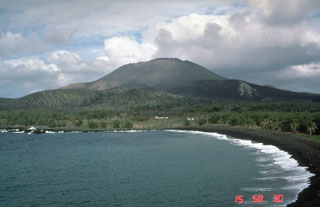Report on Pagan (United States) — 21 November-27 November 2012
Smithsonian Institution / US Geological Survey
Weekly Volcanic Activity Report, 21 November-27 November 2012
Managing Editor: Sally Sennert.
Please cite this report as:
Global Volcanism Program, 2012. Report on Pagan (United States) (Sennert, S, ed.). Weekly Volcanic Activity Report, 21 November-27 November 2012. Smithsonian Institution and US Geological Survey.
Pagan
United States
18.13°N, 145.8°E; summit elev. 570 m
All times are local (unless otherwise noted)
Clear satellite views showed steam-and-gas emissions drifting from Pagan during 17-24 November. According to the Washington VAAC, ash from an unknown volcano was reported by a pilot in the vicinity of Pagan on 25 November. Satellite imagery suggested continuing degassing, but it was possible that ash was present in a 30-km-wide plume that was drifting almost 90 km S. Mostly gas was seen drifting S in an image later that day.
Geological Summary. Pagan Island, the largest and one of the most active of the Mariana Islands volcanoes, consists of two stratovolcanoes connected by a narrow isthmus. Both North and South Pagan stratovolcanoes were constructed within calderas, 7 and 4 km in diameter, respectively. North Pagan at the NE end of the island rises above the flat floor of the northern caldera, which may have formed less than 1,000 years ago. South Pagan is a stratovolcano with an elongated summit containing four distinct craters. Almost all of the recorded eruptions, which date back to the 17th century, have originated from North Pagan. The largest eruption during historical time took place in 1981 and prompted the evacuation of the sparsely populated island.
Sources: Washington Volcanic Ash Advisory Center (VAAC), Emergency Management Office of the Commonwealth of the Mariana Islands and United States Geological Survey Volcano Hazards Program

